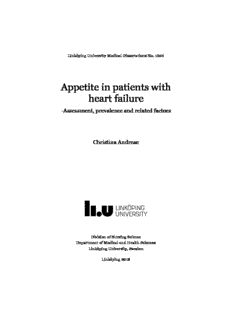
Appetite in patients with heart failure PDF
Preview Appetite in patients with heart failure
Linköping University Medical Dissertations No. 1606 Appetite in patients with heart failure -Assessment, prevalence and related factors Christina Andreae Division of Nursing Science Department of Medical and Health Sciences Linköping University, Sweden Linköping 2018 Christina Andreae, 2018 Cover picture/Illustration: Christina Andreae Published articles has been reprinted with the permission of the copyright holder. Printed in Sweden by LiU-Tryck, Linköping, Sweden, 2018 ISBN 978-91-7685-373-3 ISSN 0345-0082 To my family Henrik, Madeleine and Mathias “The appetite grows for what it feeds on” - Ida B. Wells - Contents CONTENTS CONTENTS ABSTRACT ................................................................................................. 1 LIST OF PAPERS ....................................................................................... 5 ABBREVATIONS ....................................................................................... 7 INTRODUCTION ...................................................................................... 9 BACKGROUND ........................................................................................ 11 Appetite and nutrition ........................................................................ 11 The phenomenon appetite ............................................................ 11 Biological regulation of appetite ................................................... 11 Malnutrition.................................................................................. 12 Patients with heart failure .................................................................. 14 Definition, epidemiology, etiology and prognosis ......................... 14 Heart failure symptoms and comorbidity ..................................... 14 Diagnostic criteria and therapy ..................................................... 15 Understanding decreased appetite ..................................................... 16 Factors associated with decreased appetite ..................................18 Assessment of appetite................................................................. 23 Caring for patients with decreased appetite ................................. 24 Rationale ........................................................................................... 25 AIMS ........................................................................................................ 27 METHODS ............................................................................................... 29 Study design and sample ................................................................... 29 Sample size ........................................................................................ 32 Procedure and data collection ........................................................... 32 Variables and instruments................................................................. 33 Data analysis ..................................................................................... 39 Ethical considerations ....................................................................... 43 RESULTS ................................................................................................. 45 Psychometric evaluation of CNAQ and SNAQ ................................... 46 Prevalence of appetite problems in heart failure ............................... 50 Factors associated with decreased appetite ....................................... 50 Contents Changes in physical activity and appetite over time ........................... 51 Appetite and health status .................................................................. 51 Moderation effect of depression ........................................................ 52 DISCUSSION ........................................................................................... 53 Discussion of the results .................................................................... 53 Methodological considerations .......................................................... 59 Clinical implications .......................................................................... 64 Future research ................................................................................. 65 CONCLUSIONS ....................................................................................... 67 SVENSK SAMMANFATTNING ............................................................... 69 ACKNOWLEDGEMENTS ......................................................................... 71 REFERENCES .......................................................................................... 77 APPENDIX. CNAQ AND SNAQ…………………………………………………………87 Abstract ABSTRACT Background: Appetite is an important component in nutrition for maintaining the food intake needed by the body. Decreased appetite is a common clinical problem in patients with heart failure. It has a negative impact on food intake and possibly on malnutrition and health outcomes. There is a lack of evidence on how to assess appetite in heart failure. Furthermore, there are knowledge gaps about factors associated with appetite and which role appetite plays for health status in heart failure. Aim: The overall aim of the thesis was to investigate appetite in patients with heart failure. Four studies were conducted with the goal to evaluate the psychometric properties of the Council on Nutrition Appetite Questionnaire (CNAQ) (I) and to explore the prevalence of decreased appetite and related factors associated with appetite in patients with heart failure (II-IV). Methods: A multicenter study was conducted in three outpatient heart failure clinics in the center of Sweden during 2009-2012. Data were collected through a baseline measurement (I-IV) and an 18-month follow- up (IV). The first study was a psychometric evaluation study (I), while the other studies had an observational cross-sectional design (II-III) and an observational prospective design (IV). One hundred and eighty-six patients diagnosed with heart failure and experiencing heart failure symptoms participated at baseline. At the 18-month follow-up study (IV), one hundred and sixteen participants from the baseline participated. Data were collected from medical records (pharmacological treatment, comorbidity, left ventricle ejection fraction, time of diagnosis), self-reported questionnaires (demographic background data, appetite, symptoms of depression, health status, sleep, self-reported physical activity), objective 1 Abstract measurements (anthropometric assessment of body size, blood samples, six minutes’ walk test, and physical activity measured with an actigraph) and clinical assessment (New York Heart Association (NYHA) functional classification, and cognitive assessment). The main outcome variables included appetite (I, II and IV) and health status (III). Descriptive and inferential statistics were used in the studies (I-IV). Results: The majority of the participants had moderate heart failure symptoms, i.e., NYHA class II (n=114, 61%). Most of the participants were men (n=130, 70%). Mean age was 70,7 years, (SD=11,0), and mean BMI was 28.7 (SD=5.3). The CNAQ showed acceptable psychometric properties for assessing appetite in patients with heart failure (I). This thesis shows that 38% of the participants experienced an appetite level that put them at risk of weight loss (I). It was shown that factors such as biological, medical, psychological (II) and physical activity/exercise capacity (IV) are associated with appetite. Also, appetite was associated with impaired health status. However, this association was found to be moderated by symptoms of depression (III). Neither appetite nor physical activity changed during the 18-month follow-up (IV). Conclusion: Decreased appetite is a serious phenomenon that needs attention in the care of patients with heart failure. Health care professionals can now use a validated and simple appetite instrument to assess appetite in heart failure. In addition, attention should be paid to elderly patients and those who have symptoms of depression, sleep problems, impaired cognitive function and impaired physical activity, as well as to patients on suboptimal medical treatment. Higher appetite was shown to contribute to a better health status, but this was only evident in patients without symptoms of depression. Therefore, special attention should be paid to symptoms of depression, as this risk factor affected the association between appetite and health status. This thesis enhances the understanding of the magnitude of the problem with decreased appetite in 2 Abstract heart failure both in numbers and factors. New priorities in nutrition care and new ideas can be established, both in practice and in research, in order to improve a nutrition care that is vital for patients with heart failure. Keywords: Appetite, Age, Cognitive function, Depression, Health status, Heart failure, Malnutrition, Physical activity, Psychometrics, Pharmacotherapy, Sleep 3 4
Description: